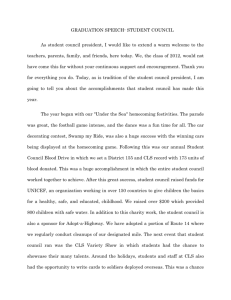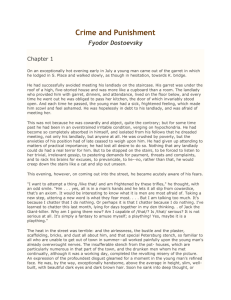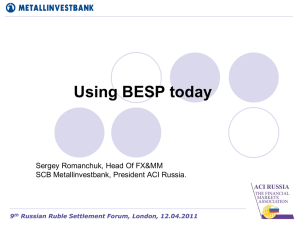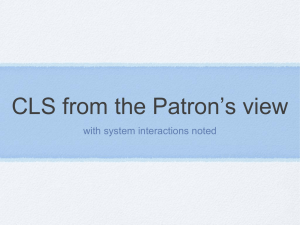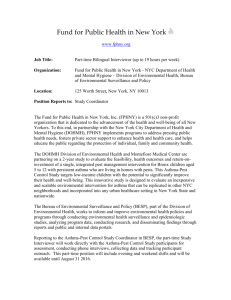Minutes of the IRSF-9
advertisement
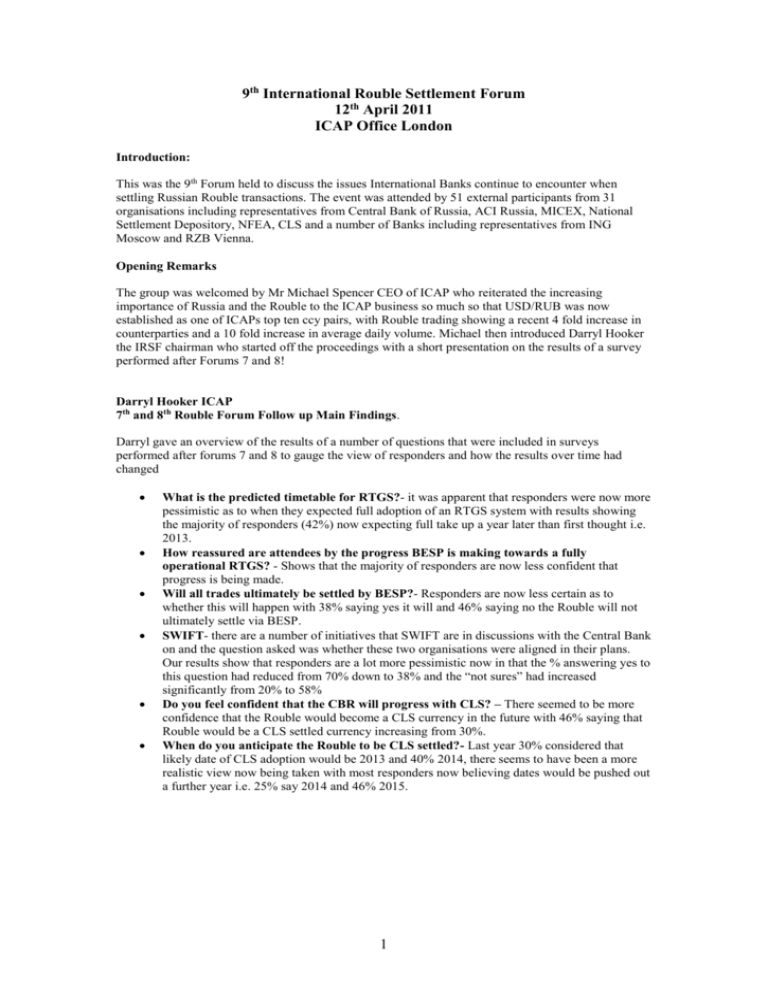
9th International Rouble Settlement Forum 12th April 2011 ICAP Office London Introduction: This was the 9th Forum held to discuss the issues International Banks continue to encounter when settling Russian Rouble transactions. The event was attended by 51 external participants from 31 organisations including representatives from Central Bank of Russia, ACI Russia, MICEX, National Settlement Depository, NFEA, CLS and a number of Banks including representatives from ING Moscow and RZB Vienna. Opening Remarks The group was welcomed by Mr Michael Spencer CEO of ICAP who reiterated the increasing importance of Russia and the Rouble to the ICAP business so much so that USD/RUB was now established as one of ICAPs top ten ccy pairs, with Rouble trading showing a recent 4 fold increase in counterparties and a 10 fold increase in average daily volume. Michael then introduced Darryl Hooker the IRSF chairman who started off the proceedings with a short presentation on the results of a survey performed after Forums 7 and 8! Darryl Hooker ICAP 7th and 8th Rouble Forum Follow up Main Findings. Darryl gave an overview of the results of a number of questions that were included in surveys performed after forums 7 and 8 to gauge the view of responders and how the results over time had changed What is the predicted timetable for RTGS?- it was apparent that responders were now more pessimistic as to when they expected full adoption of an RTGS system with results showing the majority of responders (42%) now expecting full take up a year later than first thought i.e. 2013. How reassured are attendees by the progress BESP is making towards a fully operational RTGS? - Shows that the majority of responders are now less confident that progress is being made. Will all trades ultimately be settled by BESP?- Responders are now less certain as to whether this will happen with 38% saying yes it will and 46% saying no the Rouble will not ultimately settle via BESP. SWIFT- there are a number of initiatives that SWIFT are in discussions with the Central Bank on and the question asked was whether these two organisations were aligned in their plans. Our results show that responders are a lot more pessimistic now in that the % answering yes to this question had reduced from 70% down to 38% and the “not sures” had increased significantly from 20% to 58% Do you feel confident that the CBR will progress with CLS? – There seemed to be more confidence that the Rouble would become a CLS currency in the future with 46% saying that Rouble would be a CLS settled currency increasing from 30%. When do you anticipate the Rouble to be CLS settled?- Last year 30% considered that likely date of CLS adoption would be 2013 and 40% 2014, there seems to have been a more realistic view now being taken with most responders now believing dates would be pushed out a further year i.e. 25% say 2014 and 46% 2015. 1 We asked a number of questions re Roubles recent and future development o There was little change in responders agreeing that BESP would become the main settlement system for the Rouble i.e. 82% agreed o There was a massive swing in responders agreeing that Moscow will become a major financial centre i.e. increase from 22% to 57% o Less responders believed that Rouble will become a recognised G8 currency down from 22% to 17% o Less responder’s believed that Rouble would become a reserve currency down from 11% to 8% believed in that statement. o After forum 7 there were 43% that believed Banks would offer Prime broking service, this question was no longer valid as there are now Banks that offer prime broking services in Rouble. What should BESP do to encourage full uptake of their service? From the various quotes it was clear that the main issues were and continued to be o Central Bank to make a clear statement on the mandatory up take of BESP and the retirement of the legacy system o Eliminate other settlement systems. o Reduction in transaction costs Darryl closed his presentation by advising that a further survey would be performed after the forum and that on the back of the days Agenda there was a short questionnaire entitled “30 second thoughts” which was to get attendees view on the morning’s content. There was a comment from the floor that though the results were interesting the difference in results could be put down to the different perspective between attendees from London and Moscow! Mr Dmitry Piskulov National Foreign Exchange Association (NFEA) 2011 Overview of RUB FXMM & Derivative Market Recent Developments. Mr Piskulov gave an overview of the Rouble FX, MM and Derivatives market showing the progress of Rouble trading both On Shore and Off Shore. Recent Developments o There has been an increase in BRIC trading (Brazil, Russia, India and China) but out of the 4 it does appear that Russia is growing the most. o Plans for Moscow to become an International Financial Centre have been accelerated. o As a result of a new law on clearing passed in February 2011 it is expected that by August “close out netting” will be adopted. o A new version of the Russian ISDA is close to completion… o Various new Rouble indices are either in place or due to be in place very soon which should have a positive impact on volumes. o The leading Moscow Banks are currently developing new CNY/RUB cross rate. o Issuance of a number of Rouble denominated Eurobonds in order to promote Moscow as an International Finance centre and the Rouble. It is apparent that the rouble still has a long way to go to be regarded as a “True Global Currency” as it is still predominantly a local or regional currency i.e. only 0.8-0.9% share of Global FX Turnover. There is though a slow but gradual move to globalisation in that there is a limited number of Rouble denominated securities traded internationally and so there is now a limited access for those outside of Russia to trade various Rouble instruments in the financial markets. 2 A number of slides were shown giving statistics from number of authorities such as the BIS and Bank of England to compare recent volumes Figures from the BIS show that the on shore FX Market has actually decreased slightly between 2007 and 2010 from an ADV of 50 Bln in April 2007 to 42 Bln in April 2010 in terms of % of the global volume down from 1.3% to 0.8% The domestic Rouble interbank money market is smaller than the FX market but o There has been a big increase in Domestic REPOS from $2.2 Bln in Jan10 to 5.1 Bln in February 11. o Slight decrease in interbank deposits both domestic and cross border over the same timeframe. The on shore FX Interbank market has shown a decrease from its record high in July 2008 (pre crisis) where average daily volumes were 119.2 Bln but ADT did steady in 2010 to a high of 66.7 Bln but has again decreased considerably to 39.2 Bln in February 2011. Where as on shore volumes have tended to decrease there is though growth in off shore business and a number of slides were shown to reflect this: Off Shore trading volumes reported as o Fx Instruments $12-13 Bln o Money Market instruments $0.5-1 Bln o Interest Rate Derivatives $1-2 Bln o Rouble Bonds Trading $1Bln (participants in London are particularly interested in these as a new instrument. There are more Rouble derivative products traded outside of Russia but with the inclusion of the new Rouble Bonds the number of cash products traded are rising. Overseas Counterparties of Russian Banks as at February 2011 showed o 78.9% of spot and 90.1% of FX swaps were traded with Western Europe, with London being the major hub. o 7.6% of spot and 2.2% of FX swaps were traded with Northern Europe o 5.7% of spot and 3.7% of FX swaps were traded with South America o Banks in other regions trading with Russian Banks included CIS countries, Cyprus and North America. As per UK FXJSC semi annual survey as at October 2010 o Rouble FX represented 0.7% of total FX volume for the UK, fairly constant from previous years o Turnover for USD/RUB showed 11.3 Billion up from 10.8 billion in October 2008. o Total ADT of the UK market has increased considerably to 1821 Bln in October 2011 from 1699 Bln in 2008 and 1521 Bln in 2009. Trading in Rouble FX instruments in London (as at October 2010) can be broken down as follows: o FX Swaps $4 Bln. o FX Spot $3.7 Bln an increase of 42% from April 2010 which can be put down to the growth in trading on electronic platforms. o NDF $1.6Bln o Fx Options $1.1Bln o Outrights 0.7$ o Currency swaps $0.28 Bln (doubled since April 2010) o Total $11.4 Bln (same as April 2010 though a 32% increase from April 2009) 3 All in all a positive story to tell and Mr Piskulov finished on his view as to what were the pre requisites for Moscow to become an International Finance Centre: o Develop bilateral, multilateral clearing on a Central Counterparty (CCP) basis o Continue to promote Rouble as a Reserve currency o Remove obstacles for Rouble clearing and settlement i.e. mandatory use of BESP and Rouble to clear via CLS Bank o Continue to develop Rouble bond market for overseas investments o Enhance derivative trading domestically Sergey Romanchuk Head of FX & MM SCB Metallinvestbank, President ACI Russia Using BESP Today As Metallinvest is a participant of BESP and Mr Romanchuk is the president of the Russian ACI he gave a presentation on BESP relating to both his roles. Weaknesses o Even though as at August 2010 most Russian Banks are now Associate members of BESP many of these are still not using it so still no critical mass. o Current regional payment system meets most of a Banks requirements so there is no incentive to migrate to BESP. o Costs high in comparison to current regional payment system Urgent payments via BESP are 30 Rouble and ordinary payments 25 Rouble, even discounts for high usage are very poor i.e. 0.1% Regional payment system costs range from 5 Rouble to maximum of 15.10 Roubles o Costs of supporting and developing two payment systems at the same time are very high, a certain level of development is required but currently there are no “off the shelf” IT solutions so Metallinvest did their own in house development. o Intraday liquidity between the two payment systems has to be managed manually. o As there is no payment netting in BESP there tend to be liquidity issues in that if there is no liquidity in the system it requires one of the Big Banks” to move funds first otherwise there tend to be jams. o It tends to take a long time from initial request to start using the system to getting final approval to be able to use it. To put the issues in perspective since Metallinvestbanks acceptance on the system on 27 th May 2010 to 11th April 2011, there have been 1224 receipts of funds via BESP(75 Banks) and 841 payments out VIA BESP (19Banks). The Bank tends to use BESP for special payments only! Positives o Mandatory associate membership for all domestic Banks that hold a banking License. Easy to implement system. All customers could therefore ask its Bank to effect payments via BESP. o RUB 6 is now being implemented and payment order formats are now expected to meet SWIFT requirements in August 2011. o Using BESP would give a participant advantages such as effective/quick settlement to MICEX and fast interregional payments. o As a result of the introduction of BESP the Central Bank has confirmed that the regional batch system will be abolished in 2013. o With BESP now in place the Central Bank have now started dialogue with CLS on the Rouble becoming a CLS settled currency. 4 To conclude his presentation Mr Romanchuk recalled prospects from the previous years IRSFs and future prospects 2010 o o o 2011 o o o BESP would be the main settlement system in Russia by 2011,this has not happened and will not happen this year. Rouble will be a CLS currency in the near future. Central Bank has a target of between 2013 and 2015 Prime Broking Service for FX Rouble trading will become available. This is now in place and has had a significant impact on Metallinvestbank volumes which have increased 10 fold in a year. They currently have two streams of trading via their own name and also via their prime bank. It is now believed that BESP will become the main payment system in 2013 when the old regional batch system will be replaced. Banks will begin to offer BESP third party payment services Banks will start to use BESP more for their standard urgent payments rather than as now where they are currently only using it for just special purposes. It is apparent though that the main threat to BESP remains the old regional batch system, abolish that and BESP will thrive! Mikhail Bolshakov Central Bank of Russia BESP Implementation Mr Bolshakov’s presentation revolved around 3 main items Central Banks plans to develop the Bank of Russia payment system. Interface between SWIFT and BESP. CLS Discussions. Bank of Russia payment system The plan which has been approved by the Central Bank is for changes to be made to the Bank of Russia payment system which will take the form of two stages. Stage 1 o By 2013 the current regional components will be merged into 1 large federal component so that BESP will only need to interface with one component rather than as is now 78 regional components. o To reach this goal there is still a lot of work to do: There needs to be the introduction of a uniform working time, which is difficult when the regions cross a number of different time zones. Negotiations are very close though. Need to decide how liquidity will be managed between BESP and the new Federal Component system. What settlement rules will be adopted by the Federal Component system? What will be the rules for a participant’s inclusion into BESP and the Federal Component system? o Once the Federal Component is in place the plan is that by 2013 fast and urgent payments will then be migrated to BESP. 5 Stage 2 o By 2015 the unified settlement system which will provide a different service for fast and retail payments to all Bank of Russia payment system participants will have been developed. SWIFT Interface with BESP Good progress is being made with the plans to use SWIFT as the communication channel into BESP which is still planned for 2011. A SWIFT gateway is being designed to help interaction with BESP. o They will use V shape messages i.e. messages sent direct to CBR for onward transmission rather than normal Y method where messages sent direct to the Beneficiary Bank. A new payment instruction is being designed that will be compatible with SWIFT formats this will include: o Same field length o Fields will conform to SWIFT standards. o Ability to execute payment instructions with fields that are completed in English rather than Cyrillic’s. CLS Plans. Discussions at an operational level between Central Bank and CLS began in February2011 and are ongoing. The Central Bank is fully committed for the Rouble to join CLS and estimate that Rouble inclusion will be within two years! Rachael Hoey from CLS answered a number of questions on “Rouble membership” within the CLS o There is a special “CLS Outreach Programme” that is involved in initial discussions with Central Banks as concentrated education on CLS procedures/regulations is required. o There is a number of different criteria that has to be met before a currency is accepted. o It is a requirement that there are three liquidity providing Banks “signed up” able to provide Rouble liquidity in the CLS system. These haven’t been decided yet but it is too early in the process and is low priority at the moment. o Rachael confirmed initial discussions were taking place but these were at a very early stage and there was still a long way to go! o The fact that the CBR appear fully committed to Rouble becoming a CLS currency was very positive. Julia Sergeeva VP Payments & Cash Management ING Moscow Rouble Settlements for International Banks – Key Aspects Ms Sergeeva gave a presentation highlighting the issues that a Nostro Bank based in Moscow currently have and how this ultimately impacts the International Banks. Overview of Rouble Trading: Market Participants: There are around 30 Top Russian Banks plus a number of Moscow subsidiaries of Russian Banks. Volumes have increased considerably over the last few years. o ING are turning over around 20 million Roubles daily with foreign banks. o ING seeing a growth in Rouble trading of around 11/12% per year. o They are mostly trading FX spot, FX swap’s, Rouble bonds and REPO derivatives. 6 Rouble Funding: o Foreign Banks have limited access to local Rouble funding. o Lack of local ISDA causes issues but a Russian version of the ISDA is close to completion. Rouble Settlement issues: Julia went through the current batch payment processing system highlighting the many challenges that they face issues such as Opening a Nostro account for a customer is extremely tough with the collection of documents required to set the account up taking between 3 months and a year The special formats required for Rouble payments o Manual intervention in Rouble payments is still required o Conversion of English into Cyrillic’s o Inclusion of special codes (VO) required for exchange control purposes. The main principles that ING Moscow adopt for their customers are They attempt to effect all payments in the early shifts They extend cut off times for same day value settlements They recommend their customers have an intraday overdraft facility They recommend their customers have a complete understanding of the currency control rules that they have to adhere to. Liquidity Management issues: There are a number of issues the main ones being Majority of commercial and interbank payments are processed in batches 4 or 5 when interbank market is already inactive Different Banks have differing crediting procedures. CBR does not pay interest on overnight credit balances hence clients do not receive interest either. There is no distinction between high/low value & urgent non urgent payments they are all treated the same. Back value payments are not allowed and penalty fee costs for non delivery of interbank payments are extremely high. There is no cash pooling nor sweeping facilities. ING Moscow view on RTGS Main liquidity is still in the batch based system BESP is mainly used for early payments to MICEX Only 25% of total Rouble settlements currently go through BESP BESP should be used for low volume high value payments It is not linked in anyway to the current batch based system Use of BESP is labour intensive and time consuming It is not currently compatible with SWIFT though this is imminent. Use of BESP is not mandated and even if payment is sent via BESP the recipient still has to agree to process it. ING Moscow view on what is required Online settlement required over principle RUB Nostro accounts Instant settlement netting is required. BESP must be SWIFT compatible Liquidity management issues must be resolved. 7 Rachael Hoey CLS CLS- Contributing to settlement risk reduction Rather than speak exclusively about the Rouble as a possible CLS currency, Rachael’s presentation gave a more generic view of the process/procedures that any new currency needs to adopt /achieve before being accepted as a CLS settled currency. Facts and Figures o Surveys show that settlement risk constitutes 89% of trade risk. o Liquidity required to settle is reduced by up to 98% i.e. CLS Settles around $4 trillion a day – of this amount only 50 billion is actually required in order to settle. o CLS settles up to 90% of the interdealer FX market. o CLS settles 17 currencies accounting for 94% of daily traded value. o It offers standard legal framework and operating rules and therefore resolves the issues of different interpretations of “netting finality” in different locations. o CLS is owned by the major FX Banks globally. o CLS “passed the test” during the financial crisis of September 2008 and beyond. Currency eligibility requirements o The currency must have a minimum sovereign rating of BB-/Ba3 o Legally the currency must be able to achieve finality of settlement and pay ins i.e. currency balances must not be able to be “unpicked”. o The local banking system must be stable. o There must be domestic support from the local banking community strong commitment from the central bank Must have a minimum of one local bank as a shareholder/participant There must be three local currency liquidity providers able to put liquidity in that currency into the CLS system in an emergency o There must be very specific know your customer rules in place and a high level of due diligence. o The Real Time Gross Settlement system must be able to meet rigid timed pay- ins as there is a very limited settlement window between 6.00am and 9.00am. The RTGS system must also be compatible with SWIFT standards. Benefits of a currencies inclusion in CLS. o Through the elimination of settlement risk it enhances the financial stability of the currency o The real time reporting available via the CLS system enhances the oversight of global trading in any local currency. o Local currency funding requirements for FX settlements are reduced. o Reduced credit needs helps improve market growth. o Improved STP efficiencies. o Domestic Banks can benefit from extra business development opportunities such as becoming Nostro accounts and or offering 3rd party services. CLS new currency programme o The CLS is keen to include any internationally traded currency that meets their eligibility criteria and currently discussions are far advanced with Turkey, Thailand and Chile. o A CLS outreach programme helps educate Central Bank authorities as to the currencies “requirements” to become a CLS currency, concentrated education is required before any new currency can be considered for entry into CLS. o The more currencies settled in the system the greater settlement risk elimination for the global FX market. 8 o SWOT teams engage in discussions with various local authorities to evaluate the possible risks involved in accepting a new currency. Rachael closed her presentation by commenting that a Central Banks commitment to wanting their currency to be included in the CLS is most important and it is apparent from hearing comments at the forum that the Central Bank of Russia has a “will to join CLS” and its hoped therefore that Rouble will become a CLS settled currency in the future. Sergey Sukhinin Deputy Chairman of the Board National Settlement Depository NSD – The New Element of Russian Financial Infrastructure Mr Sukhinin gave a presentation on the creation of the National Settlement Depository which was formed from the integration of two different businesses i.e. MICEX Settlement House and the National Depository Centre both members of the MICEX group. MICEX Settlement House o Largest Russian non- banking credit organisation. o Provider of settlements in all markets that MICEX are involved in o Provider of settlements in OTC markets o Authorised settlement centre in organised Securities market National Depository Centre o Largest Russian settlement depository servicing all types of securities o Provider of DvP settlement services for primary and secondary markets o Settlement Depository for three of the Russian stock exchanges. The new entity was officially registered on 03rd November 2010. National Settlement Depository o An organisation that provides the whole range of services of a settlement depository and a non banking credit organisation i.e. provides full range of settlement services for securities and cash. o Improves quality of service. o Reduced costs and more attractive tariff policy. o Acts like a Mini Central Bank as it can hold the accounts of Russian Banks and other Financial Institutions Benefits of effecting Cash settlements via the NSD. The NSD does not offer credit facilities and therefore has no credit risk. Payment processing is fully automated It is a direct participant of BESP. It benefits from extended operational deadlines for Rouble and other foreign currency payments. Mr Sukhinin concluded with a very detailed vision for the NSD leading up to 2014 with the main aim being for a merger between MICEX and the Russian Trading System (Russian stock exchange) which will make it one of the Top 10 exchanges in the world. Igor Marich Vice President MICEX Latest Developments Mr Marich confirmed that there were 7 regional centres for MICEX across Russia primarily involved in Clearing and Settlement in a number of different instrument types. It is the major exchange in Russia and currently ranks 21st by volume amongst the world’s exchanges that trade in stocks. 9 Mr Marich then continued with some statistics and their plans for the future. The majority of MICEX currency volume is concentrated in 3 major pairs namely USD/RUB, EUR/RUB and EUR/USD with a market share in USD/RUB of 30% and in EUR/RUB just over 50%. Next Steps. o A new Risk Management system is being developed Will increase efficiency and therefore decrease costs There will be a single collateral required across all instruments Portfolio approach to risk evaluation of all instruments. Single position per currency and settlement date. Collateral may change during and after trading depending on changes in volatility. o Two Tier Membership There will be Direct Market access (DMA) to MICEX currency market Enabling foreign Banks to access liquidity o New Fee Structures Reduced fee’s for liquidity providers A more flexible fee structure Penalties incurred for breaking fill ratio’s o New MICEX currency market instruments Currently there is strong support to change value date convention for basket rouble currency pairs Back in December CNY/RUB was launched which has proved to be very successful. New ccy pairs such as UAH/RUB, BYR/RUB and KZT/RUB with a value date of T + 0 Danny Corrigan ICAP Global Growth of Rouble Market Overview Danny gave a brief overview of the Development of International trading in the Rouble over the last 10 years. Highlights being 1998- Nobody would touch the Rouble for trading. 2000-01 New Government under Putin was elected, which was the pre cursor to the take off of Rouble trading 2006 The biggest gas company Gazprom shares became highly valuable, FX controls were lifted but FX trading though more active still tended to be traded from London as there were still no branches in Moscow. 2008-09 Rouble Bank accounts could now be opened, automated trading i.e. spot USD/RUB traded on EBS. 2010-11 Many more RUB bank accounts opened, close out netting is imminent, products traded new Eurobonds, Domestic equities, ADRs, GDRs, Spot FX, Forward FX, SWAPs (CCS, IRS, Basis) and OIS 2012+ What does the future hold? A workable real time gross settlement system will lead to “membership” of the CLS. New products likely to be Domestic Bonds, Debt and equity repos plus RDRs. To conclude Russia and Rouble is a success story and it is only going to get better! 10 Closing Remarks/Wrap Up Darryl Hooker thanked all the speakers for their informative presentations and to the attendees for their input to a successful forum! Main take aways from the forum Russia and the Rouble are increasing in importance in ICAP. NFEA advised that there are a number of new developments in the pipeline such as close out netting and a new version of the Russian ISDA. There has been a massive increase in spot Rouble trading. We continue to hear that BESP has “many members but not many users”, there are many reasons for this i.e. it’s costly to run two payment systems and there is a lack of incentives to use BESP. Sergey says the main threat to BESP is the old system! Good to hear from the Central Bank that their payment development concept and the liaison with SWIFT are progressing well. Also that they hope for the Rouble to be included in the CLS system in 2 years. We heard from Julia at ING Moscow on a correspondent Banks view on the issues they currently face and what they believe is required for BESP to be successfully adopted i.e. Instant Settlement netting and SWIFT compatibility. A very interesting presentation from Rachael from the CLS on the very rigorous processes that a currency needs to go through before adoption as a settled currency. Rouble is still very early in the process but the most important factor is that the Central Bank of Russia are showing a real commitment for the Rouble to join. The new National Settlement Depository highlighted their plans for the next three years in particular that the merged MICEX/Russia Trading System expects to be one of the Top 10 exchanges in the world. MICEX is the major exchange in Russia currently ranked 21 st globally and their market share in the currency markets continue to be quite substantial Finally we heard from Danny at ICAP who gave a synopsis of how Rouble trading had developed over the last 10 years, which is now a real success story! Rouble trading has now reached the “Tipping Point” and can only go on increasing substantially. Progress is continuing and we look forward next time to hearing how the Central Banks plans to replace the regional payment system with a single Federal payment system are progressing and also the latest news on the CBRs discussions with CLS. 11
